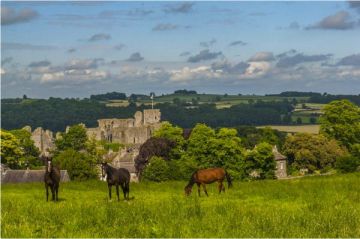The Tower of London is steeped in history. Begun by the Normans to control the native population of the City of London, it has served as a royal residence, a military stronghold, a menagerie, a royal mint, and a prison. It houses the Crown Jewels and is at the heart of the oldest military ceremony in the world. With over 150 permanent residents, it is like a small community within greater London.
Let's take a closer look at the Tower's history, outline some fascinating facts and figures, and answer some of the most common questions visitors have about this famous fortress on the bank of the River Thames.
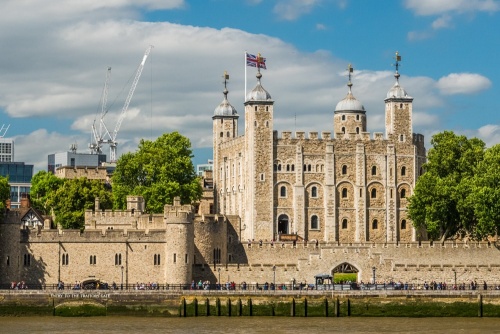
Facts and Figures
What is the Tower of London's official name?
The Tower's official name is Her Majesty's Royal Palace and Fortress of the Tower of London. What a mouthful! It's no wonder that we simply shorten the official name to the much simpler version.
Where is it?
The Tower stands, appropriately enough, just inside the London borough of Tower Hamlets, on the north bank of the River Thames. The location is immediately west of the old square mile of the City of London, created from the original Roman walled city.
How old is it?
The Tower was begun in 1066 by William the Conqueror to exert his precarious control over his new kingdom's largest city. Londoners resented the Normans and saw the castle as a symbol of the hated Norman elite that had seized control of their country.
What is the oldest part of the Tower of London?
The oldest part of the Tower is the White Tower, built by William the Conqueror in 1078, over a decade after the castle was begun. It is this Norman tower that gave us the name 'Tower of London', though that name is now applied to the entire complex of buildings that surround the White Tower.
How many towers are there at the Tower of London?
There are twenty-one towers. The central tower, begun by William the Conqueror, is known as the White Tower. The others are:
- Bloody Tower
- Beauchamp Tower
- Bell Tower
- Bowyer Tower
- Brick Tower
- Broad Arrow Tower
- Byward Tower
- Constable Tower
- Cradle Tower
- Develin Tower
- Devereux Tower
- Flint Tower
- Lanthorn Tower
- Martin Tower
- Middle Tower
- St Thomas Tower
- Salt Tower
- Wakefield Tower
- Wardrobe Tower
- Well Tower
St Thomas's Tower (begun in 1275), Wakefield Tower (begun in 1220), and the Lanthorn Tower are collectively known as 'The Medieval Palace'. They formed the core of the royal residence at the heart of the medieval Tower of London. The three towers were built by Henry III and his heir Edward I. Though Edward put money into the Medieval Palace, he only stayed there for 53 days in total out of his 35 years on the throne.
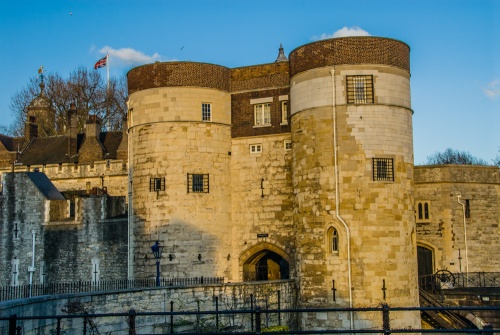
Prisoners at the Tower of London
Was the Tower always a prison?
No, the Tower of London was first and foremost a military stronghold that evolved into a royal residence. Though it is often thought of as a gaol because of the prominent people who were held there, its primary role was never as a prison. Many of those held at the Tower were not treated badly, but often had their own quarters and even their own servants.
Who was the first prisoner at the Tower of London?
The first prominent prisoner that we know of was Ranulf Flambard, Bishop of Durham and advisor to William Rufus (William II). When Henry I seized the throne after William II's sudden death in 1100 he held Flambard prisoner in the Tower. Flambard promptly became the first person to escape from the Tower and fled to France where he threw his support behind Henry's brother Robert Curthose, Duke of Normandy.
How did Flambard Escape?
Rather cleverly. He had a long rope smuggled to him, hidden in a barrel of wine. He then gave a banquet for his captors and plied them with drink. When they were suitably muddled with alcohol, he slid down the rope and made his escape.
Who was the last prisoner held at the Tower of London?
In 1952 the infamous Kray twins, Ronnie and Reggie, were held at the Tower, not for the murders which eventually saw them incarcerated for the rest of their lives, but for failing to report for national service. The Krays are thought to be among the last few prisoners held in the Tower.
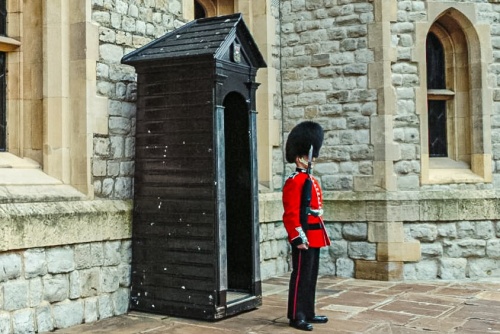
Who lives at the Tower of London?
As of this writing, roughly 150 people make the Tower of London their home. This includes the Yeoman Warders (the Beefeaters) and their families, a doctor, chaplain, and the Tower's Governor. And of course, the famous ravens.
The Tower is still officially a royal residence. The monarch could, at any time, choose to move in, though this hasn't happened for centuries. The royal residence is called Queen's House when a queen is on the throne and King's House when the monarch is male.
How many sentries are there?
Usually two, one guarding the Jewel House, where the Crown Jewels are kept, and the other in front of Queen's House. The Queen's House sentry is silent, that is, he or she does not stamp and make loud noises when on duty so as to avoid disturbing the residents of Queen's House.
The Tower of London Ravens
We can't talk about the Tower of London without mentioning its resident ravens. According to legend, if the ravens ever leave the Tower, the kingdom will fall. To prevent the birds from leaving, their wings are trimmed (but not clipped) and they are well fed and cared for. They can, and occasionally do, fly away and have to be replaced.
How many ravens live at the Tower of London?
There are always at least six 'official' ravens in residence, plus 'spares' just in case something happens to one of the other six. As of this writing, there are nine ravens living at the Tower.
What do the ravens eat?
The ravens feed twice a day and enjoy a diet consisting largely of mice, rats, chicken, and other raw meat. On special occasions they receive biscuits soaked in blood.
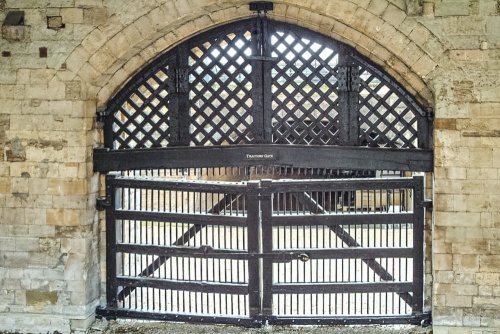
Executions at the Tower
How many people were executed in the Tower?
Fewer than you might think. Until the 20th century, only seven people were executed in the Tower of London (nine if you include the Princes in the Tower, who weren't executed but disappeared, presumed murdered).
That total rises to 12 if you include three soldiers, members of the Black Watch, who were executed by military firing squad on 19 July 1743 after being found guilty of mutiny.
The Tower was used as a prison during both the First and Second World Wars, primarily to hold those accused of espionage. A dozen prisoners were executed as spies during this time.
Who was executed at the Tower of London?
Let's be very precise in our terminology. Seven people were executed on Tower Green, within the Tower grounds, near the chapel of St Peter ad Vincula. This relatively private space, far from gawking crowds, was reserved for prisoners of high status.
The seven people executed on Tower Green were:
- William Hastings, 1st Baron Hastings, 1483
- Queen Anne Boleyn, second wife of King Henry VIII, 19 May 1536
- Margaret, Countess of Salisbury, 27 May 1541
- Queen Catherine Howard, fifth wife of Henry VIII, 13 February 1542
- Jane Boleyn, Viscountess Rochford, 13 February 1542
- Lady Jane Grey, 12 February 1554
- Robert Devereux, 2nd Earl of Essex, 25 February 1601
All of these prisoners were executed by beheading. Anne Boleyn was executed by a skilled swordsman brought from France, especially for the occasion, and the others were executed with an axe.
Far more prisoners who were held in the Tower of London were taken to nearby Tower Hill (or other public places) for execution. From 1500 to 1900 at least 112 people held in the Tower were taken to Tower Hill to be executed in front of crowds, because it was thought that their deaths would act as a deterrent.
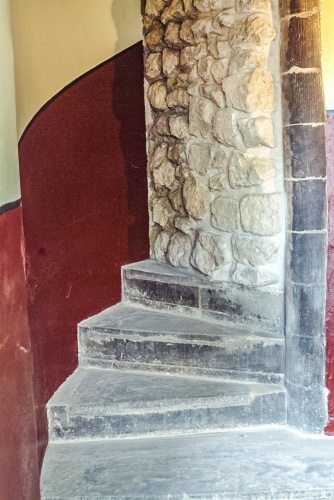
Who was the first person executed at the Tower?
The first person that we know of to be executed inside the Tower of London was William Hastings, 1st Baron Hastings (1431-1483). Hastings was a powerful advisor to Edward IV, but on Edward's death his brother Richard, Duke of Gloucester and Lord Protector, accused Hastings of conspiring to kill him.
Accounts of what happened next are contradictory. Some versions say that Hastings was hauled out of a council meeting and summarily executed on Tower Green, without a trial. Other versions suggest that he was tried a week later by a Court of Chivalry and executed on 20 June 1483.
Hastings was not, however, the first known prisoner to die at the Tower of London. That 'honour' goes to Gruffydd ap Llywelyn Fawr, the eldest son of Llywelyn the Great.
Gruffydd was imprisoned in the Tower in 1241. Three years later in 1244 he tried to escape. He tied together several sheets and pieces of cloth to create a makeshift rope and tried to lower himself down the wall from the window of his quarters inside the Tower. Unfortunately, the rope broke under his weight and Gruffydd fell to his death.
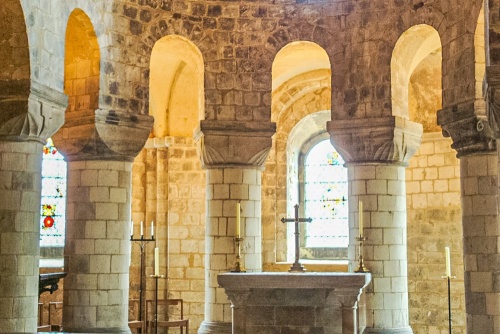
Murders at the Tower
Public executions are one thing, but some prisoners met a violent end in other ways. The most famous of these deaths was the [presumed] murder of the Princes in the Tower. The princes, sons of Edward IV, were held in the Tower in 1483 on the orders of their uncle Richard, Duke of Gloucester (later Richard III). The princes disappeared from public view and were never seen again. Their disappearance turned public opinion against Richard, who was presumed to have ordered their murders.
Years later, workmen repairing a stairwell found the skeletons of two young boys. These were presumed to be the missing princes and were reburied with ceremony at Westminster Abbey.
King Henry VI was held prisoner at the Tower in 1471 by the future Edward IV. On 21 May 1471, Henry was murdered, some say by Edward's own hand, while kneeling at prayer in the King's Private Chapel in the Wakefield Tower.
Who was the last person executed at the Tower?
Josef Jakobs (1898-1941) was a member of the Abwehr, the intelligence department of the German Army. He was captured by the Home Guard a day after parachuting into the UK near Ramsey in Huntingdonshire. He was tried before a military tribunal and executed by firing squad on 15 August 1941. He was buried in an unmarked grave at St Mary's Catholic Cemetery in Kensal Green. The Windsor chair to which he was tied for the execution is on display in the Tower.
Who was held prisoner in the Tower for the longest time?
Sir William de la Pole was held for 37 years, from 1502 until his death in 1539. De la Pole was in the line of succession to the throne through his mother Elizabeth Plantagenet, Duchess of Suffolk.
In fact, his claim was better than that of King Henry VII, so when De la Pole's brothers were embroiled in a plot to overthrow King Henry, the king took no chances and had Sir William incarcerated.
Guy Fawkes at the Tower
There have been many interrogations of prisoners at the Tower of London, but perhaps none more famous than the interrogation of Guy Fawkes, the Gunpowder Plot conspirator, whose plot to kill King James I was foiled on 5 November 1605. After Fawkes was captured in a cellar beneath the Houses of Parliament he was taken to the Tower of London to be questioned by members of the king's council.
The interrogation took place in the Great Hall of the King's House, a timber-framed Elizabethan building overlooking Tower Green. Here, Fawkes was questioned by Sir William Waad, Lieutenant of the Tower. It seems very likely that Fawkes was then taken to the dungeons under the white tower to be tortured on the rack.
In 1608 Sir William Waad had a marble memorial installed on the wall of the Council Chamber in the King's House to commemorate the foiling of the Gunpowder Plot. The memorial lists all those who were present when Fawkes was questioned.
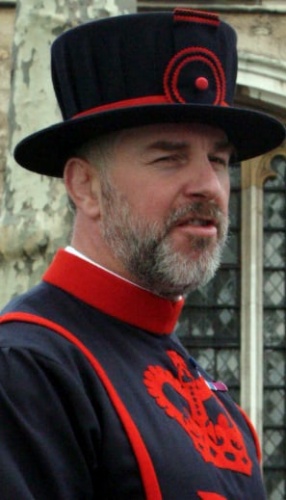
The Yeoman Warders
How many Yeoman Warders are there?
There are 32 Yeoman Warders (Beefeaters) stationed at the Tower of London. Despite the name, Yeoman can be male or female. All Yeomen are members of the Armed Forces. They must have at least 22 years of military service, have reached at least the rank of warrant officer, and have been awarded a good conduct medal and a long service medal. Each new Yeoman Warder must take an oath of allegiance, the terms of which were laid out in 1337. The ornate state dress uniforms cost over £7,000 apiece.
What is the Ceremony of the Keys?
This nightly ceremony sees the Chief Yeoman Warder lock all of the Tower of London's outer gates for the night. The ceremony takes place at precisely 9.53 pm each evening and is the oldest military ceremony in the world. After the doors are locked, the keys are delivered to the Governor, the monarch's direct representative.
Is the Tower of London haunted?
Of course! Ghosts have been reported at the Tower for centuries. Among the spectral figures most frequently seen are the spirits of Anne Boleyn, Henry VI, Lady Jane Grey, Margaret Pole, and the Princes in the Tower. Those might be expected, since they were all executed or murdered in the Tower, but one ghost might be a surprise; it is the spectral figure of a grizzly bear that once formed part of the royal menagerie.
The Tower as a Zoo
The Tower once housed the royal collection of exotic animals, most of which were gifts from foreign monarchs. The first animals to arrive were three leopards (or possibly lions) given to Henry III by the Holy Roman Emperor Frederick II in 1235. The king added a polar bear in 1252 and an elephant in 1255. The polar bear, a gift of the King of Norway, is recorded as fishing for meals in the Thames.
King Edward I created a permanent home for the royal menagerie in the Lion Tower, the western entrance to the Tower grounds. Over the centuries the menagerie was home to pumas, eagles, tigers, a jackal, leopards, and lions.
The menagerie was downsized in 1826 by the Duke of Wellington in his role as Constable of the Tower. Under the Duke's orders, 150 animals were sent to new quarters in Regent's Park, where they formed the basis of what would become in time the ZSL Regent's Park Zoo. The menagerie closed completely in 1835 and the remaining animals were sent to other zoos or circuses.
The Tower as a Royal Mint
Edward I moved the Royal Mint to the Tower of London sometime around 1279. It continued in operation until 1810, a period of 510 years. The Mint was housed in a complex of buildings in the Outer Ward known as Mint Street. It was dangerous work, and mint workers frequently lost fingers and eyes and constantly breathed noxious fumes.
The official in charge of minting coins was the Master of the Mint. The most famous Master was Sir Isaac Newton, who was known for successfully catching forgers.
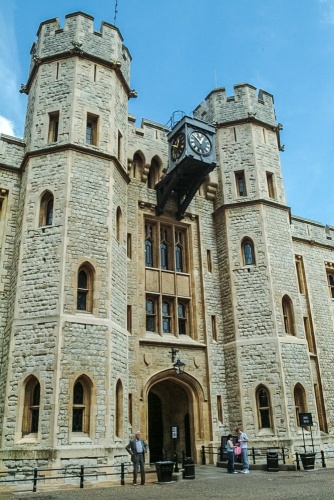
The Crown Jewels
What are the Crown Jewels?
The Crown Jewels are the reigning monarch's collection of ceremonial regalia, including crowns, jewels, and robes. They have been kept at the Tower of London since 1661, though monarchs had kept valuable items at the Tower for over 600 years.
The medieval Crown Jewels were broken up and melted down by Oliver Cromwell and Parliament during the English Civil War in 1649. When Charles II was restored to the throne, he had new regalia made, including a coronation crown, a state crown, an orb, a sceptre, swords, spurs, a ring, and bracelets.
What is the oldest item in the Crown Jewels?
The oldest piece in the collection is an 11th-century gold spoon, used during the coronation ceremony to anoint the monarch with holy oil. Other pieces to survive Cromwell's epic meltdown were three 17th-century swords.
The Crown Jewels have escaped danger at least twice. In 1671 Colonel Thomas Blood was almost successful in his attempt to steal the jewels. Blood and a pair of accomplices fooled the Jewel House Keeper into letting them handle the jewels. No sooner did the Keeper give them access to the jewels than they beat him and tried to run off with the Orb, the Imperial State Crown, and Sovereign’s Sceptre.
Luckily, the Keeper's son raised the alarm and the thieves were caught. In a peculiar twist, King Charles pardoned Colonel Blood and gave him a pension, leading some historians to conclude that the king, desperate for money, had hired Blood to steal the jewels in the first place.
The Crown Jewels escaped damage in 1841 when the Grand Storehouse, located next to the Jewel House, caught fire. The jewels were carried away to safety in the nick of time.
MOST POPULAR POSTS



